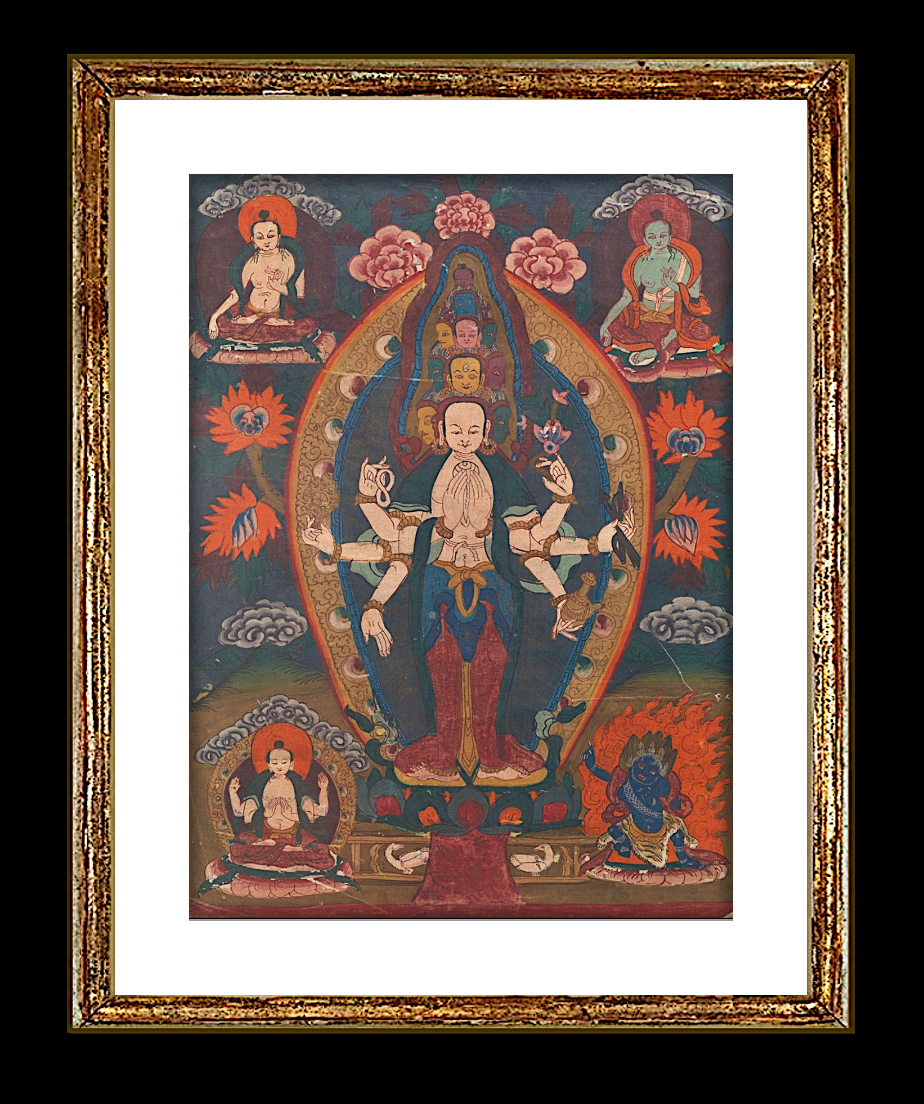

Title: 19th Century Antique Tibetan Tribal Hand-Painting Thangka
Shipping: $29.00
Artist: N/A
Period: 19th Century
History: Ancient Art
Origin: Central Asia > Nepal
Condition: N/A
Item Date: N/A
Item ID: 460
A 19th-century Tibetan Hand-Painted Thangka on Silk-Linen Blend. Consisting of hand-painted polychrome Colors. The Black Yamantaka Ekavira wrathful emanation of Manjushri, with multiple heads and multiple arms on lotus throne among clouds with dark background. 16 ⅝" x 12 ⅛" Provenance: old private collection, acquired in Kathmandu, Nepal, in mid 1970's-1980's. The Black Yamantaka Ekavira is a wrathful emanation of Manjushri, the bodhisattva of wisdom, in Tibetan Buddhism. The deity is depicted with multiple heads and arms, seated on a lotus throne surrounded by clouds, against a dark background. The imagery of Yamantaka has a long and rich history in Tibetan Buddhism, with roots dating back to ancient Indian Buddhism. According to legend, Yamantaka was originally a demon who terrorized the gods and humans. However, the Buddha, in his wisdom, realized that the demon's true nature was that of a bodhisattva who had become trapped in the demon's form. The Buddha then tamed the demon, transforming him into a deity of compassion and wisdom. Over time, the imagery of Yamantaka became associated with the practice of tantra in Tibetan Buddhism. In this context, Yamantaka is seen as a powerful deity who can help practitioners overcome their negative emotions and attain enlightenment. The Black Yamantaka Ekavira is a particularly powerful form of Yamantaka, known for his ability to destroy ignorance and other obstacles on the path to enlightenment. The deity's multiple heads and arms represent his power and ability to overcome all obstacles, while his lotus throne and the clouds that surround him symbolize his transcendence of the physical world. The dark background against which the deity is depicted is also significant. It represents the emptiness or voidness of all things, which is a central concept in Tibetan Buddhism. This voidness is not a negative or nihilistic concept, but rather represents the infinite potential and possibility that exists in all things. Overall, the Black Yamantaka Ekavira is a powerful and complex symbol in Tibetan Buddhism, representing the transformative power of wisdom and compassion over ignorance and suffering. The deity's imagery has a long and rich history, and continues to inspire and empower practitioners today.
Tibetan Buddhist paintings, also known as thangkas, have a long and rich history that dates back over a thousand years. These paintings are typically created on cotton or silk fabric, and are often adorned with brocade or silk borders. Thangkas serve as visual aids for meditation and as objects of devotion in Tibetan Buddhism. The origins of thangka painting can be traced back to the 7th century CE, when Buddhism was first introduced to Tibet from India. The earliest thangkas were likely created by Indian artists, who taught their techniques to local Tibetans. These early thangkas depicted Buddhist deities and teachings, and were used to help spread Buddhism throughout Tibet. Over time, thangka painting developed into a distinct art form in its own right, with its own unique styles and techniques. Thangkas became more complex and intricate, with detailed depictions of deities, mandalas, and other symbolic images. One of the most important developments in the history of thangka painting was the establishment of the Karma Gardri tradition in the 15th century. This tradition, which is still practiced today, is known for its highly precise and detailed depictions of deities and other figures. Thangkas also played an important role in the development of Tibetan Buddhist monasticism. Monks would often spend many years studying and meditating on thangkas, using them as tools for spiritual development and enlightenment. In addition to their religious significance, thangkas are also highly valued as works of art. Many thangkas have been created by famous artists throughout history, and are considered to be masterpieces of Tibetan Buddhist art. Today, thangka painting remains an important aspect of Tibetan culture and religion. Thangkas are still created by artists using traditional techniques, and are widely used in meditation and worship. They are also highly valued by collectors and art enthusiasts around the world.